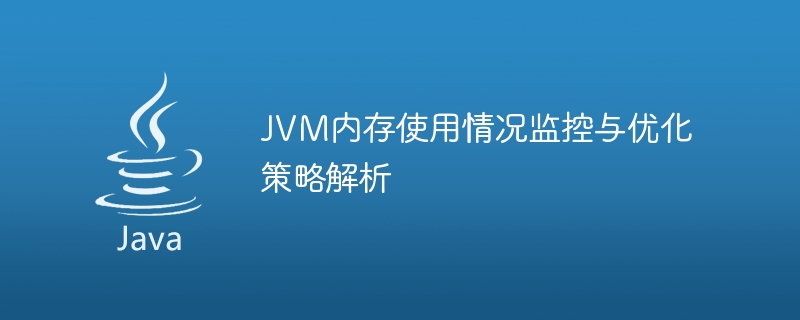

JVM memory usage monitoring and optimization strategy analysis
In Java development, JVM memory management is an important topic. Properly monitoring and optimizing the JVM's memory usage can improve application performance and stability. This article will introduce how to monitor the memory usage of JVM and give some optimization strategies to improve application performance.
1. Classification of JVM memory usage
JVM memory is mainly divided into the following areas:
2. JVM memory monitoring
The memory usage of the JVM can be obtained through the API provided by JMX, as shown below:
import java.lang.management.MemoryPoolMXBean;
import java.lang.management.ManagementFactory;
List<MemoryPoolMXBean> memoryPools = ManagementFactory.getMemoryPoolMXBeans();
for (MemoryPoolMXBean memoryPool: memoryPools) {
String name = memoryPool.getName();
MemoryUsage usage = memoryPool.getUsage();
long used = usage.getUsed();
long max = usage.getMax();
System.out.println("Memory Pool: " + name);
System.out.println(" Used: " + used);
System.out.println(" Max: " + max);
}Through the above code, the usage of each memory pool in the JVM can be obtained, including the Memory used and maximum available memory.
The JVM's garbage collection (GC) log records various garbage collection events and memory usage. By analyzing GC logs, you can learn the frequency and time-consuming of GC, as well as memory allocation and release, thereby discovering memory problems and potential optimization points. You can use tools such as GCViewer to analyze GC logs.
3. JVM memory optimization strategy
The size of the heap memory directly affects the performance of the application. If the heap memory is too small, it may cause frequent garbage collection and affect the response time of the application. If the heap memory is too large, memory resources may be wasted. The size of the heap memory can be adjusted through the -Xms and -Xmx parameters, where -Xms specifies the initial size of the heap memory, and -Xmx specifies the maximum size of the heap memory.
JVM provides a variety of garbage collection algorithms, such as Serial, Parallel, CMS and G1, etc. Different algorithms are suitable for different scenarios. The appropriate garbage collection algorithm can be selected based on the characteristics and needs of the application. The garbage collection algorithm can be specified through parameters such as -XX: UseSerialGC, -XX: UseParallelGC, -XX: UseConcMarkSweepGC, and -XX: UseG1GC.
Frequent creation and destruction of objects will increase the burden of garbage collection. You can reduce object creation and destruction by reusing objects or using object pools. In addition, you can release objects in time to avoid memory leaks by manually releasing resources or using try-with-resources.
Optimizing code and algorithms can reduce memory usage. For example, more efficient data structures can be used to reduce the number of objects. It can also avoid creating unnecessary temporary objects and reduce memory usage.
Can analyze and tune the configuration parameters of garbage collection according to the needs of the application, including young generation size, old generation size, GC trigger conditions, etc. You can track the frequency and time consumption of garbage collection, adjust parameters in a timely manner, and optimize application performance.
4. Summary
JVM memory management is an important part of Java development. Properly monitoring and optimizing the JVM's memory usage can improve application performance and stability. By using JMX monitoring tools and analyzing GC logs, you can understand the memory usage of the JVM and discover problems and potential points for optimization. At the same time, the memory usage of the JVM can be optimized by adjusting the heap memory size, selecting appropriate garbage collection algorithms, controlling the creation and destruction of objects, optimizing code and algorithms, and tuning GC configuration. Only by deeply understanding the JVM's memory management and optimization technology can we better leverage the advantages of Java.
The above is the detailed content of JVM memory usage monitoring and optimization strategy analysis. For more information, please follow other related articles on the PHP Chinese website!




